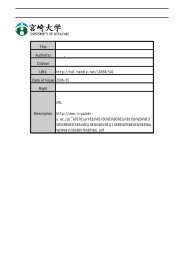Micrococcus luteus - 宮崎大学
Micrococcus luteus - 宮崎大学
Micrococcus luteus - 宮崎大学
Create successful ePaper yourself
Turn your PDF publications into a flip-book with our unique Google optimized e-Paper software.
is described by the following spin Hamiltonian;<br />
H = μΒ [g ⊥(HxSx + HySy) + g// Hz] + A ⊥(SxIx + SyIy) + A// SzIz (1)<br />
where μB is the Bohr magneton, g ⊥= (gxx + gyy)/2 and g// = gzz, the principle axis<br />
components of g-values, A ⊥= (Axx + Ayy)/2 and A// = Azz, the principle axis components<br />
of hyperfine coupling constant, Hx, Hy, Hz, the components of outer magnetic field , Sx,<br />
Sy, Sz, the components of electron spin, Ix, Iy, Iz, the components of copper nuclear spin,<br />
S = 1/2 and I(Cu) = 3/2. The g-values are given as follows (modified from Abragam and<br />
Pryce, 1951; Gersmann and Swalen, 1962);<br />
g// = ge (1 - 4λ/Δ1) (2)<br />
g ⊥ = ge (1 - λ/Δ2) (3)<br />
A// = P[-α 2 (4/7 + κ) + (g// - ge) + (3/7)(g ⊥ - ge)] (4)<br />
A ⊥ = P[-α 2 (2/7 - κ) + (11/14)(g ⊥ - ge)] (5)<br />
where ge = 2.0023 ; the g-value of free electron, λ ; the spin-orbit coupling constant (-828<br />
cm -1 for free Cu(II) ion), Δ1 = E(dxy) - E(dx 2 - y 2 ), Δ2 = E(dxz) - E(dx 2 - y 2 ); the ligand<br />
field constants, P; the dipole term (0.036 cm -1 for free Cu(II) ion), α 2 ; the d-electron<br />
density of Cu(II) ion, and κ ; the correction for Fermi contact term. Thus, g// and |A//|,<br />
being associated with the ligand field constants and the d-electron density of Cu(II) ion,<br />
can be often be used to assign structures of copper complexes (Peisach & Blumberg<br />
1974). A part of the EPR spectrum of Cu(II) ion in the chemically treated <strong>Micrococcus</strong><br />
cells were shown in Fig. 3, and the parameters obtained from these spectra, g//, |A//|, and Δ1<br />
(estimated as λ = -828 cm -1 ) were listed in Table 3. The EPR spectra indicate the typical<br />
powder pattern of Cu(II) ion in a tetragonally distorted octahedral environment. As g// and<br />
|A//| in Table 3 are in the range of 2.247 ~ 2.280 and 17.6 ~ 19.1 mcm -1 , Cu(II) in each<br />
cells, having ligands with nitrogen and oxygen donor atoms, will be in a similar<br />
10




